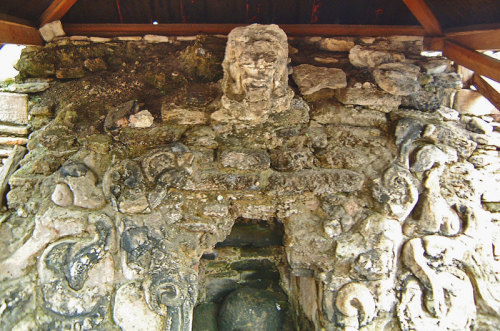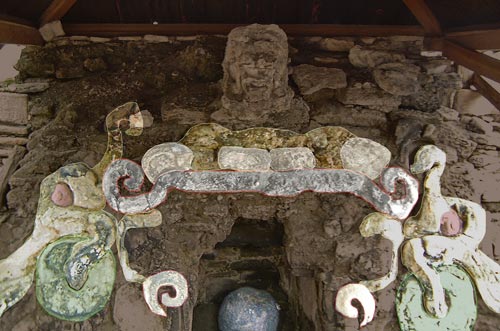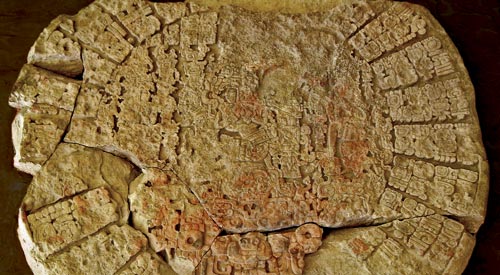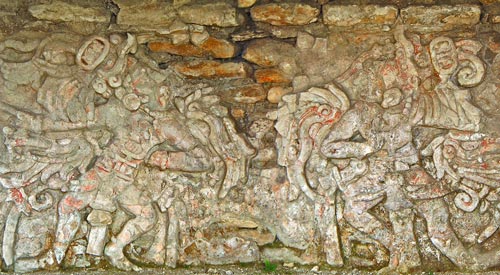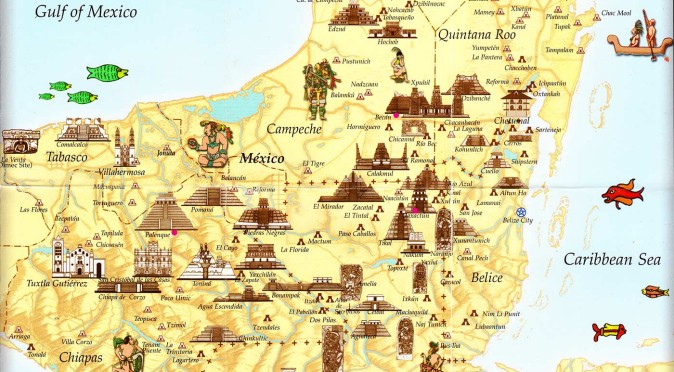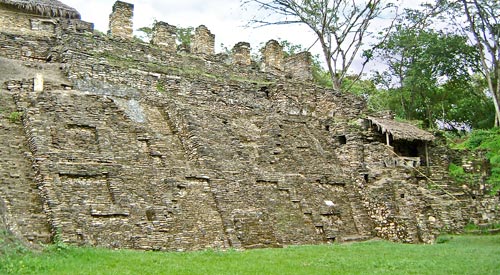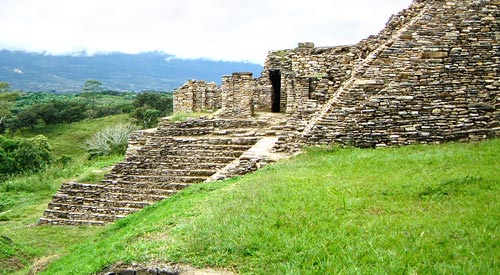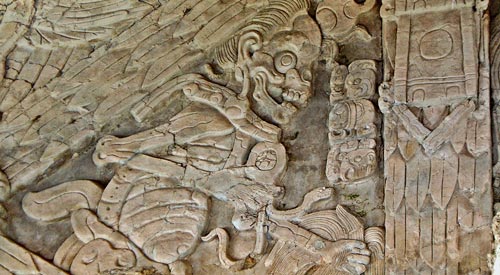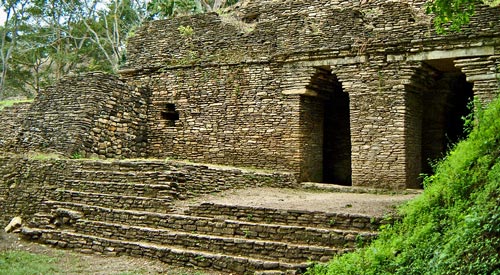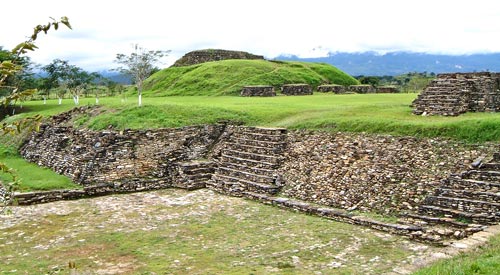The Temple of the Earth Monster is located upon the sixth tier of Tonina’s incredible stepped-pyramid acropolis and is thought to have been built in the 8th century. The Temple of the Earth Monster takes its name from a sculpted Altar of the Earth Monster, known as Structure E5-5, that is attached to the the front of the temple. The altar is in a poor state of disrepair, but you can still make out the gaping mouth of the Earth Monster, who may alternatively be known as the Witz Monster or Kawak Monster (Witz meaning “mountain” and Kawak meaning “storm” or “lightening”). The small piercing eyes are the most easily identifiable feature on the altar and are located in-line and either side of the top of the mouth (coloured in red in figure W0456C). Two pairs of curling fangs can be seen around the mouth opening (coloured white in fig W0456C), although these may also represent snakes held within the monsters jaws. The monster is looking upward with its head is tipped right back, therefore its ears appear beneath the eye and are represented by the two ear spools (shaded green in W0456C). The upper lip, snout and nostrils are possibly visible along the top of the mouth, but the altar is so badly damaged it is hard to be certain of their form. Inside the mouth is a mysterious sphere, which may represent an egg, water, the earth or another planet. Above the mouth appears to be the remains of a stucco head that would have represented the ruler who commissioned the Temple of the Earth Monster to be built. This last feature is unusual, because in examples found elsewhere in other Mayan cities, the ruler is shown emerging or resting in the jaws of the Earth Monster (see figs W1121BM & W0975) – a pose that is thought to represent his divine birth and sacred lineage.
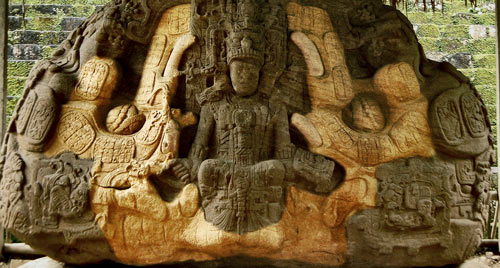 W0975 Quirigua: Zoomorfo P – Turtle Mouth
W0975 Quirigua: Zoomorfo P – Turtle Mouth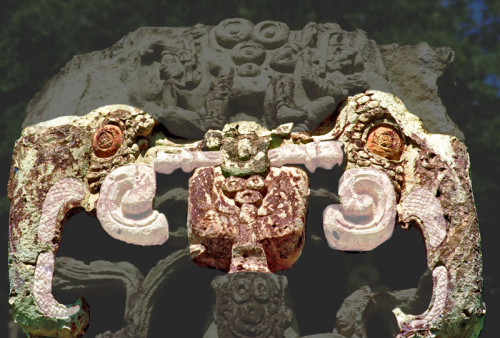 W1121BM Copan: Stela B – Monster Mouth
W1121BM Copan: Stela B – Monster Mouth
What is the Mayan Earth Monster?
The Earth, Witz or Kawak Monster is a mysterious creature that is found throughout Mayan monumental art, especially in the Late Classic period at Copan and Quirigua. It is thought that the monster represents either the earth or a mountain, and that the gaping mouth represents a cave entrance where divine rulers enter and leave the underworld – hence rulers are often picture resting in the jaws of the monster to associate them with the sacred cave. The monster is normally represented with curling fangs that are easily mistaken for elephant tusks (see the article The Elephants of Copan). Curling fangs are not something seen in nature, which means they are either an artistic reference to the sacred spiral (covered in depth in the article on the Palace of the Grecas) or meant to be snakes held within the mouth rather than fangs.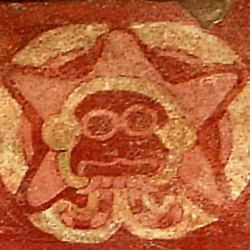 W2-0019T: Tlaloc The use of a snake held in the mouth or an unusually long forked serpentine tongue is often seen in images of the Mayan Water God, Chac (derived from kawak / cauac), and the Teotihuanaco Water God, Tlaloc. Other cultures also associated snakes with water and in particular the water found underground or within caves. The Teotihuacano themselves are thought to have derived the infamous feathered-serpent from the image of an owl fetching a serpent from a cave1 and it is thought that the goggle-eyes of Tlaloc are representative of the owl’s ability to traverse the darkness of the underworld (see fig. W2-0019T taken from the Palace of the Jaguars at Teotihuacan, which shows Tlaloc with a serpent in his mouth – an image that is perhaps the precursor to the invention of the Feathered-Serpent or Quetzalcoatl). If the curling fangs are representative of a serpent held within the monster’s jaws, then it may be fair to assess that the Temple of the Earth Monster is closely linked to water and specifically the water that flows from the underworld.
W2-0019T: Tlaloc The use of a snake held in the mouth or an unusually long forked serpentine tongue is often seen in images of the Mayan Water God, Chac (derived from kawak / cauac), and the Teotihuanaco Water God, Tlaloc. Other cultures also associated snakes with water and in particular the water found underground or within caves. The Teotihuacano themselves are thought to have derived the infamous feathered-serpent from the image of an owl fetching a serpent from a cave1 and it is thought that the goggle-eyes of Tlaloc are representative of the owl’s ability to traverse the darkness of the underworld (see fig. W2-0019T taken from the Palace of the Jaguars at Teotihuacan, which shows Tlaloc with a serpent in his mouth – an image that is perhaps the precursor to the invention of the Feathered-Serpent or Quetzalcoatl). If the curling fangs are representative of a serpent held within the monster’s jaws, then it may be fair to assess that the Temple of the Earth Monster is closely linked to water and specifically the water that flows from the underworld.
Are the Witz, Kawak & Earth Monster Related?
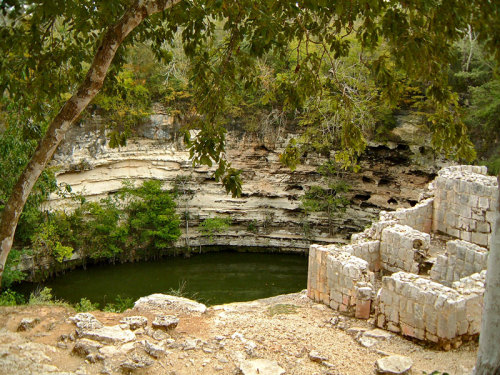 X0459: Cenote at Chichen Itza Caves and water were closely linked in a variety of ways. Firstly, water drips into the caves from the ground above to produce stalactites and stalagmites – these may have been likened to monstrous teeth and spawned the concept of the Earth, Kawak and Witz Monster. Secondly, underground caves often have streams or rivers flowing through them that would have seemingly come from the underworld and appeared very special. Mexico is also renowned for its extensive network of underground caves that run beneath the water-table and can be accessed through large pond like openings and sink-holes known as cenotes. These underwater caves found in the heart of the jungle are known to have been considered as entrances to the underworld and ceremonies and sacrifices were offered to these pools to honour the gods (see fig. X0459 of the cenote at Chichen Itza in which human sacrifices were found). In summary, the Earth, Witz and Kawak Monsters are probably all fantastical representations of a cave leading to the underworld that is filled with monstrous stalactite teeth and with water mysteriously flowing from within it. The variation then comes from whether the sacred cave was considered to be beneath a mountain or beneath the jungle floor.
X0459: Cenote at Chichen Itza Caves and water were closely linked in a variety of ways. Firstly, water drips into the caves from the ground above to produce stalactites and stalagmites – these may have been likened to monstrous teeth and spawned the concept of the Earth, Kawak and Witz Monster. Secondly, underground caves often have streams or rivers flowing through them that would have seemingly come from the underworld and appeared very special. Mexico is also renowned for its extensive network of underground caves that run beneath the water-table and can be accessed through large pond like openings and sink-holes known as cenotes. These underwater caves found in the heart of the jungle are known to have been considered as entrances to the underworld and ceremonies and sacrifices were offered to these pools to honour the gods (see fig. X0459 of the cenote at Chichen Itza in which human sacrifices were found). In summary, the Earth, Witz and Kawak Monsters are probably all fantastical representations of a cave leading to the underworld that is filled with monstrous stalactite teeth and with water mysteriously flowing from within it. The variation then comes from whether the sacred cave was considered to be beneath a mountain or beneath the jungle floor.
![]() W1084-7Q: Copan – Carved Bench In Mayan art, water is represented by circles that are often arranged triangles. The example of the Monster from Copan’s Stela B includes three clear uses of this water symbol (see fig W1121BM or click here to see image close-up), which is why it is called the Kawak/Cauac Monster despite its open jaws clearly being designed to represent a cave. Another version of the Earth Monster is found on a beautifully crafted carved bench in Copan’s Structure 10L-18 (see fig. W1084-7Q). The bench features alternating images of the Kawak Monster and the Jaguar Monster, with the circular symbols of water found in between. The image of the Kawak Monster on the carved bench of Structure 10L-18 also has distinctive filed buck teeth and holds a serpent in his mouth, much like the image of Tlaloc at Teotihuacan and the Temple of the Earth Monster at Tonina. The Temple of the Earth Monster doesn’t have any visible circles around the altar to associate it with water, but the sphere held within its cavernous mouth opening could be a three-dimensional form of the water circle.
W1084-7Q: Copan – Carved Bench In Mayan art, water is represented by circles that are often arranged triangles. The example of the Monster from Copan’s Stela B includes three clear uses of this water symbol (see fig W1121BM or click here to see image close-up), which is why it is called the Kawak/Cauac Monster despite its open jaws clearly being designed to represent a cave. Another version of the Earth Monster is found on a beautifully crafted carved bench in Copan’s Structure 10L-18 (see fig. W1084-7Q). The bench features alternating images of the Kawak Monster and the Jaguar Monster, with the circular symbols of water found in between. The image of the Kawak Monster on the carved bench of Structure 10L-18 also has distinctive filed buck teeth and holds a serpent in his mouth, much like the image of Tlaloc at Teotihuacan and the Temple of the Earth Monster at Tonina. The Temple of the Earth Monster doesn’t have any visible circles around the altar to associate it with water, but the sphere held within its cavernous mouth opening could be a three-dimensional form of the water circle.
Associations between the Temple of the Earth Monster, the Maize God and Itzam Na
The Kawak Monster on Structure 10L-18 at Copan (fig. W1084-7Q) is associated with the Maize God, or God K, via the sweeping hair and mirror on his forehead. Analogies between Temple of the Earth Monster at Tonina and the Maize God can also be found elsewhere amongst the carvings of Copán.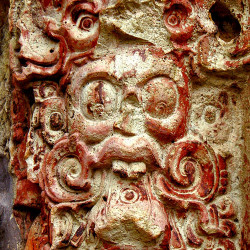 W1122: Decoration on Stela C On Stela C at Copán, for example, there is a small decoration of the Maize God following his decapitation by the Lords of Xibalba (fig. W1122). This image has a distinctive likeness to the Temple of the Earth Monster at Tonina, with the swirling fangs (that may actually represent a serpent held within his mouth) and the filed rabbit-like buck teeth that are seen on the bench of Structure 10L-18. These buck teeth appear to be present on the Temple of the Earth Monster at Tonina, but it is hard to be certain due to its deterioration. The Maize God can be considered as the Maya’s premier God and the first father of the Mayan civilisation. Divine rulers considered themselves to be the direct descendants and the living incarnation of the Maize God and their Royal Lineages were believed to stretch right back to the beginning of time. In fact, these representations of rulers resting in the jaws of a cave/monster are generally thought to have been designed to forge an association with a divine lineage and all of these identifiable components (curling fangs / serpents in mouth, buck teeth, water drops, monstrous jaws) were used to associate the person or creature with the various legends and supernatural aspects. So rather than considering the Earth Monster and the Maize God as related, it may be better to consider them as having the same supernatural powers or being associated in some other way – for example, the addition of the Earth Monster’s motifs on the face of the Maize God may be designed to tell us that this scene represents him rising from the Sacred Cave.
W1122: Decoration on Stela C On Stela C at Copán, for example, there is a small decoration of the Maize God following his decapitation by the Lords of Xibalba (fig. W1122). This image has a distinctive likeness to the Temple of the Earth Monster at Tonina, with the swirling fangs (that may actually represent a serpent held within his mouth) and the filed rabbit-like buck teeth that are seen on the bench of Structure 10L-18. These buck teeth appear to be present on the Temple of the Earth Monster at Tonina, but it is hard to be certain due to its deterioration. The Maize God can be considered as the Maya’s premier God and the first father of the Mayan civilisation. Divine rulers considered themselves to be the direct descendants and the living incarnation of the Maize God and their Royal Lineages were believed to stretch right back to the beginning of time. In fact, these representations of rulers resting in the jaws of a cave/monster are generally thought to have been designed to forge an association with a divine lineage and all of these identifiable components (curling fangs / serpents in mouth, buck teeth, water drops, monstrous jaws) were used to associate the person or creature with the various legends and supernatural aspects. So rather than considering the Earth Monster and the Maize God as related, it may be better to consider them as having the same supernatural powers or being associated in some other way – for example, the addition of the Earth Monster’s motifs on the face of the Maize God may be designed to tell us that this scene represents him rising from the Sacred Cave. 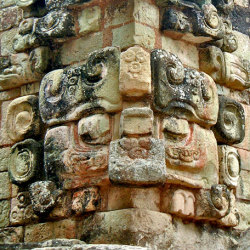 W1099: Copan – Chac That said, there is growing speculation that both the Earth Monster and the Maize God may be aspects of another God, named Itzam Na (meaning “Reptile House”), who was believed to have planted the three hearth stones that created the home for humankind. Itzam Na is normally portrayed as an elderly man with a large nose and toothless mouth, but there are examples that show great similarities with the Kawak Monster found on the bench of Copan’s Temple 18 (fig. W1084-7Q) and the typical image of Chac (such as that found on Templo 22 at Copan, see fig. W1099). However, the name “Reptile House” and the emblematic constructions of all of these images again suggest they are designed to communicate a lineage rather than a God or supernatural. In summary, the Earth/Witz/Kawak Monster is probably used to describe a divine lineage rather than an association to a specific cave – although the two are very much linked, especially if the divine lineage is that of “Reptile House” and is named after a sacred serpent filled cave.
W1099: Copan – Chac That said, there is growing speculation that both the Earth Monster and the Maize God may be aspects of another God, named Itzam Na (meaning “Reptile House”), who was believed to have planted the three hearth stones that created the home for humankind. Itzam Na is normally portrayed as an elderly man with a large nose and toothless mouth, but there are examples that show great similarities with the Kawak Monster found on the bench of Copan’s Temple 18 (fig. W1084-7Q) and the typical image of Chac (such as that found on Templo 22 at Copan, see fig. W1099). However, the name “Reptile House” and the emblematic constructions of all of these images again suggest they are designed to communicate a lineage rather than a God or supernatural. In summary, the Earth/Witz/Kawak Monster is probably used to describe a divine lineage rather than an association to a specific cave – although the two are very much linked, especially if the divine lineage is that of “Reptile House” and is named after a sacred serpent filled cave.
Is the Temple of the Earth Monster actually a Shrine to the Ancestors?
 W0750C: Lamanai – Stela 9 All around Mesoamerica and dating back as far as the Olmec right through to the Aztec, rulers are consistently pictured on monuments either emerging from a cave/mouth or wearing headdresses that create the vision of their head being held within the jaws of the monster (see fig. W0750C, a distant example from Lamanai, Stele 9). Therefore, it is curious that the Temple of the Earth Monster at Tonina does not have a ruler held within the jaws of the monster and instead has a head looking down from above (and this may actually have been a nose!). Inside the mouth, instead of a ruler we find a strange sphere that may represent water, but is also very reminiscent of a planet or an egg. We could therefore be looking at a different creation myth, one which starts with an egg, with the head looking down and witnessing the birth/creation event. There is an alternative possibility though, and this is highlighted on Lamanai, Stela 9 (fig. W0750C). On Stela 9, Lord Smoking Shell is depicted cradling the sceptre of kingship in his arms from which the “Vision Serpent” emerges with a little character known as God K resting in its jaws. This evokes an alternative understanding of heads emerging from the mouths of serpents. It is known that male rulers would pierce their genitals and drip the blood onto paper to be burned during vision ceremonies. The smoke produced from burning the divine blood would invoke the spirits of his ancestors and enable him to communicate with them. Such communications are recorded in stone with the meandering smoke represented by the Vision Serpent and the apparition of the ancestor or God shown emerging from the Vision Serpents mouth (i.e. appearing from within the smoke). Such performances were an important part of the ruler’s ritual obligations, although the significance may have been as much about proving his lineage as it was about receiving instructions from these apparitions. The altar in front of the Temple of the Earth Monster may have functioned as a place where these rituals were performed, with blooded paper burned within the monsters gaping jaws and the head above appearing to emerge from the smoke and talk. As such, the Temple of the Earth Monster could be viewed as a shrine to the ancestors rather than an altar dedicated to a mysterious beastly cave-monster.
W0750C: Lamanai – Stela 9 All around Mesoamerica and dating back as far as the Olmec right through to the Aztec, rulers are consistently pictured on monuments either emerging from a cave/mouth or wearing headdresses that create the vision of their head being held within the jaws of the monster (see fig. W0750C, a distant example from Lamanai, Stele 9). Therefore, it is curious that the Temple of the Earth Monster at Tonina does not have a ruler held within the jaws of the monster and instead has a head looking down from above (and this may actually have been a nose!). Inside the mouth, instead of a ruler we find a strange sphere that may represent water, but is also very reminiscent of a planet or an egg. We could therefore be looking at a different creation myth, one which starts with an egg, with the head looking down and witnessing the birth/creation event. There is an alternative possibility though, and this is highlighted on Lamanai, Stela 9 (fig. W0750C). On Stela 9, Lord Smoking Shell is depicted cradling the sceptre of kingship in his arms from which the “Vision Serpent” emerges with a little character known as God K resting in its jaws. This evokes an alternative understanding of heads emerging from the mouths of serpents. It is known that male rulers would pierce their genitals and drip the blood onto paper to be burned during vision ceremonies. The smoke produced from burning the divine blood would invoke the spirits of his ancestors and enable him to communicate with them. Such communications are recorded in stone with the meandering smoke represented by the Vision Serpent and the apparition of the ancestor or God shown emerging from the Vision Serpents mouth (i.e. appearing from within the smoke). Such performances were an important part of the ruler’s ritual obligations, although the significance may have been as much about proving his lineage as it was about receiving instructions from these apparitions. The altar in front of the Temple of the Earth Monster may have functioned as a place where these rituals were performed, with blooded paper burned within the monsters gaping jaws and the head above appearing to emerge from the smoke and talk. As such, the Temple of the Earth Monster could be viewed as a shrine to the ancestors rather than an altar dedicated to a mysterious beastly cave-monster.
References:
1 http://www.mesoamericancalendarstudies.com/quetzalcoatl.html

